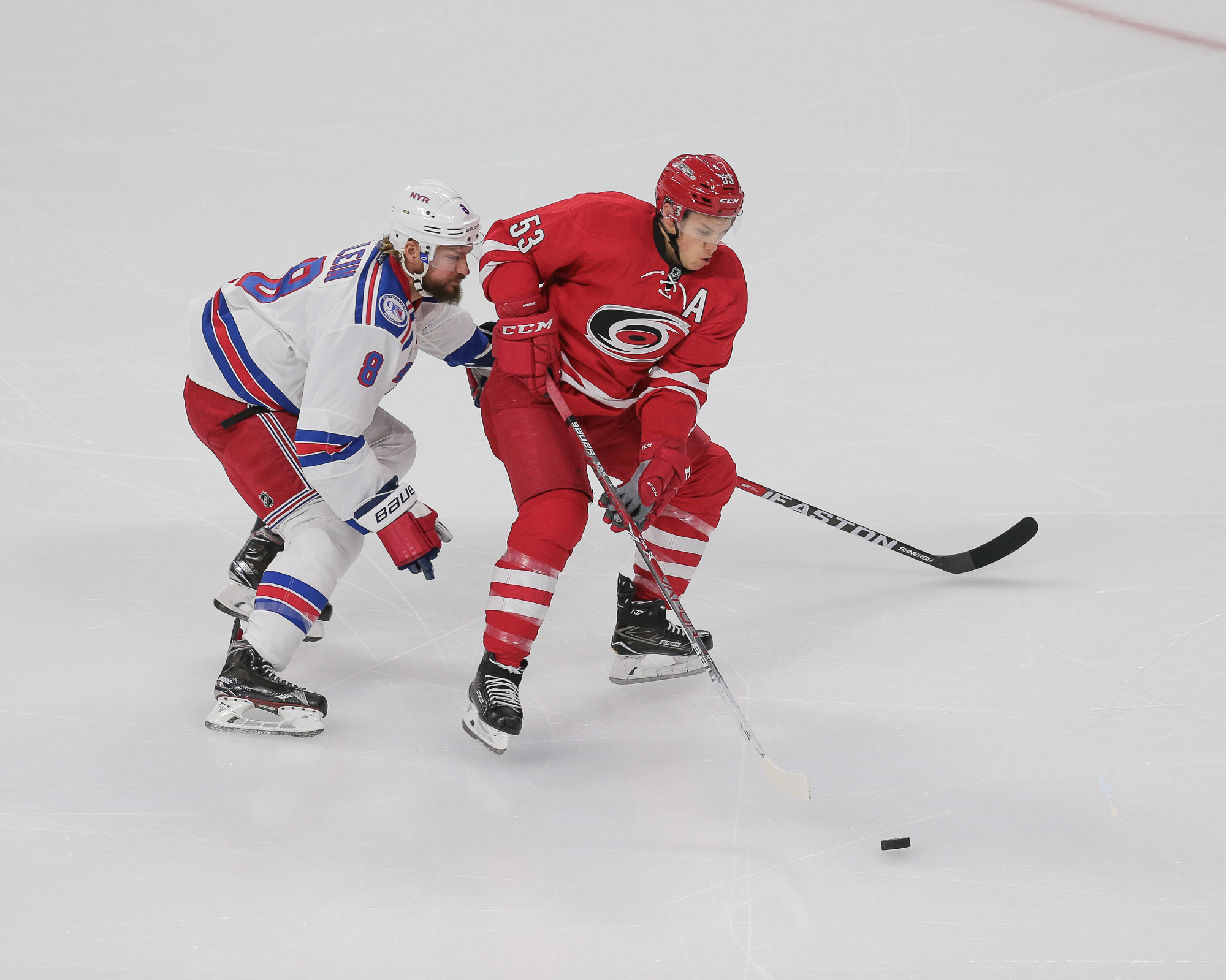
By Peter Koutroumpis
RALEIGH, N.C. – The Carolina Hurricanes open their 2017-2018 NHL season against the Minnesota Wild at PNC Arena on Saturday.
Following a 5-2 preseason slate of games played in preparation of beginning their 20th season in the league, the team comes into it ready to do battle while hopefully understanding how to adjust to the NHL’s emphasis on enforcing specific rules.
While head coach Bill Peters and his staff will have to be more vigilant and selective on challenging offside calls, and assistant coach Rod Brind’Amour will continue to school the centers on how to properly set for the faceoff according to the ‘written rule’, the most significant rule emphasis for this season will be the slashing or ‘wrist slap’ infraction.
Memories of last season’s notable slashing transgressions are still fresh in many people’s minds, be it Pittsburgh forward and captain Sidney Crosby’s whack on Ottawa defenseman Mark Methot’s hand that severely cut his finger, or Minnesota and former Hurricanes forward and captain Eric Staal’s swipe on Calgary forward Johnny Gaudreau’s finger that required surgery and a 10-game layoff.
Causing injury is not the intended consequence of the slash.
According to Staal, when asked about it in an interview on SportsNet last season, he said, “obviously it’s unfortunate for a player of his caliber to go down, and that injury to happen, but I mean it’s part of the game. Slashes happen. That’s not gonna be the last time he’s gonna be slashed or not the last time I’ve ever been slashed. I feel bad the kid’s missed time. It’s one of those things that’s unfortunate.”
For decades, as much as hooks and slashes on the wrists and hips have been a part of the game to slow faster and skilled players as well as to provide a psychological intimidation presence in said player’s mind, the emphasis on slashing this season will be monitored and scrutinized.
However, as Staal pointed out back then, don’ expect t that slashing won’t happen or disappear from the game, just like NHL Rule 61.1 will always be enforced to whatever degree accordingly.
—
Rule 61.1 – Slashing (NHL Rulebook, page 86 – Video (NHL.com)
Slashing is the act of a player swinging his stick at an opponent, whether contact is made or not. Non-aggressive stick contact to the pant or front of the shin pads, should not be penalized as slashing. Any forceful or powerful chop with the stick on an opponent’s body, the opponent’s stick, or on or near the opponent’s hands that, in the judgment of the Referee, is not an attempt to play the puck, shall be penalized as slashing.
—
Carolina’s leading scorer last season, and recently named assistant captain, Jeff Skinner concurred with his former teammate when asked about the issue following Thursday’s practice.
“I think whenever you’ve got the puck, guys are trying to get the puck off you, and whenever you don’t have the puck, you’re tryin’ to take it off someone else,” Skinner said.
“The rules are there obviously to prevent anything that’s unfair. When you’re defending, in order to get the puck off some of these skilled players, sometimes you have to sort of push the edge I think. That’s why it’s part of the game. On the flip side, you wanna make it tough on the opposition to take the puck off you, and it’s a little bit tougher when you can’t disrupt them. It’s something as the season goes along, and I think as the preseason went along, you saw guys get a feel for how it’s being called. Guys will always adapt; players will always adjust to how things are being called and find ways to compete.”
Even with the NHL’s increased emphasis on enforcing the rule better, Skinner, like Staal, will continue to go about playing and competing the way he knows and needs to in order to help his team earn a win.
It’s just a part of the game – one which both players have amply been recipients of unwanted and illegally contacted pressure on the hands and body from the opposition.
Bottom line – bear down and keeping moving forward because in the long run, the game will play out accordingly.
“It’s all part of competing, trying to get the puck as best you can without takin’ a penalty. Obviously, it’s a penalty because you’re getting an unfair advantage,” Skinner concluded.
“If you cross the line too many times, you’re gonna hurt your team the other way. I think it’s almost, the game within the game. You’re trying to win those little battles as best you can without hurting or hindering your team. I think that it’s something that as the season goes along guys will get a feel for it. There’s gonna be slashes, just like there’s still gonna be trips and interference, all these penalties. No more than any other year, I think guys will always try to get the puck off of you at any means necessary within the rules. Once they figure out what boundaries they can push, they’ll try and push until they can’t push any more. Then it ends up working in the offensive players’ favor. Really, it’s up to the referees and to the league as to how they want it to be called, and it’s up to us players to adjust to that, and play the game accordingly.”
—
Peter Koutroumpis: 401-323-8960, @pksport
